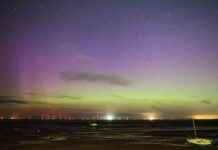There is a chance to witness the stunning Northern Lights in some U.S. states on Thursday night, just before a predicted geomagnetic storm watch that could align with the Perseid meteor shower over the weekend.
A series of coronal mass ejections from active sunspots were released on Wednesday, and they are expected to be visible this weekend. The National Oceanic and Atmospheric Administration has issued a moderate G2 geomagnetic storm watch for Friday and Saturday, but there is a possibility of seeing the Northern Lights on Thursday night.
The aurora forecast for Thursday night shows a KP index of four, indicating that the lights will be more visible and brighter to viewers, making them a delightful sight under the right viewing conditions.
The upcoming aurora display might coincide with the Perseid meteor shower, which is set to peak between Sunday night and Monday morning. However, the meteor shower can still be observed in the days leading up to its peak.
Solar activity has been unusually active in recent months as the sun’s 11-year solar cycle nears its expected peak between late 2024 and early 2026. Sunspots are expected to intensify over the next year, potentially leading to more geomagnetic storms.
While it is challenging to pinpoint the exact locations where the Northern Lights will be visible, Canada and Alaska may have the best view on Tuesday night. In the continental U.S., states like Washington, Idaho, Montana, North Dakota, South Dakota, Minnesota, Wisconsin, Michigan, Maine, and the northernmost part of New York could also witness the aurora.
For the best Northern Lights viewing experience, it is recommended to travel as close to the poles as possible, away from city lights and light pollution. Monitoring weather forecasts for optimal viewing conditions and finding a vantage point like a hilltop are also advised.
Photographing the Northern Lights can be done with smartphone cameras, which are sensitive enough to capture the aurora even when it is not visible to the naked eye. Using night mode on smartphone cameras can enhance exposure and capture the beauty of the lights.
Solar Cycle 25, the 11-year cycle of the sun, has been causing geomagnetic storms that lead to Northern Lights sightings. NASA predicts that Cycle 25 will continue into next year, with a peak expected between late 2024 and early 2026. The cycle is projected to reach its maximum with 115 sunspots, the source of geomagnetic storms.
As scientists anticipate more geomagnetic storms leading up to 2025, it is uncertain when these storms will occur, but the sun’s increased activity suggests that more captivating Northern Lights displays may be on the horizon.



